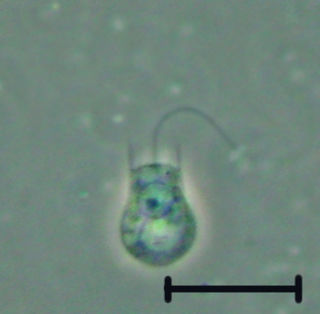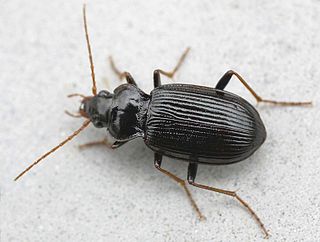Related Research Articles

The choanoflagellates are a group of free-living unicellular and colonial flagellate eukaryotes considered to be the closest living relatives of the animals. Choanoflagellates are collared flagellates having a funnel shaped collar of interconnected microvilli at the base of a flagellum. Choanoflagellates are capable of both asexual and sexual reproduction. They have a distinctive cell morphology characterized by an ovoid or spherical cell body 3–10 µm in diameter with a single apical flagellum surrounded by a collar of 30–40 microvilli. Movement of the flagellum creates water currents that can propel free-swimming choanoflagellates through the water column and trap bacteria and detritus against the collar of microvilli, where these foodstuffs are engulfed. This feeding provides a critical link within the global carbon cycle, linking trophic levels. In addition to their critical ecological roles, choanoflagellates are of particular interest to evolutionary biologists studying the origins of multicellularity in animals. As the closest living relatives of animals, choanoflagellates serve as a useful model for reconstructions of the last unicellular ancestor of animals.

Sigilmassasaurus is a controversial genus of spinosaurid dinosaur that lived approximately 100 to 94 million years ago during the middle of the Cretaceous Period in what is now northern Africa. Named in 1996 by Canadian paleontologist Dale Russell, it contains a single species, Sigilmassasaurus brevicollis. The identity of the genus has been debated by scientists, with some considering its fossils to represent material from the closely related species Spinosaurus aegyptiacus, while others have classified it as a separate taxon, forming the clade Spinosaurini with Spinosaurus as its sister taxon.

Stephan von Breuning was an Austrian entomologist who specialised in the study of beetles (Coleopterology), particularly within the longhorn family (Cerambycidae).

Nebria brevicollis is a species of ground beetle native to Europe and the Near East. In Europe, it is found in all countries and islands except the Azores, the Canary Islands, the Channel Islands, Franz Josef Land, Gibraltar, Madeira, Malta, Monaco, the North Aegean Islands, Novaya Zemlya, San Marino, the Selvagens Islands, Svalbard and Jan Mayen, and Vatican City. It has now been reported as introduced in western Oregon, U.S.A., where it has been found in highly disturbed sites as well as in native old-growth forest stands. It has also now been found in Washington State, Northern California, as well as in Southern British Columbia, Canada(See external link to iNaturalist, below). This species is most abundant between October and December, then from January through mid-May. Although Nebria brevicollis is widely considered to be solely carnivorous, multiple small studies made by enthusiasts have proven that many Nebria brevicollis will resort to eating various types of fungi that can be found in the soil they live on/around. Studied made by the same individuals have also shown that Nebria brevicollis are semi-social, and will often work together when faced with certain obstacles.

Pogonocherini is a tribe of longhorn beetles of the subfamily Lamiinae.

Hybolasius is a genus of longhorn beetles of the subfamily Lamiinae, containing the following species:
Hybolasius fasciatus is a species of beetle in the family Cerambycidae. It was described by Broun in 1881. It is known from New Zealand.
Hybolasius genalis is a species of beetle in the family Cerambycidae. It was described by Broun in 1903. It is known from New Zealand. It contains the varietas Hybolasius genalis var. tumidellus.
Hybolasius laticollis is a species of beetle in the family Cerambycidae. It was described by Broun in 1903. It is known from New Zealand.
Hybolasius modestus is a species of beetle in the family Cerambycidae. It was described by Broun in 1880. It is known from New Zealand.
Hybolasius parvus is a species of beetle in the family Cerambycidae. It was described by Broun in 1880. It is known from New Zealand. It contains the varietas Hybolasius parvus var. pusillus.
Hybolasius promissus is a species of beetle in the family Cerambycidae. It was described by Broun in 1880. It is known from New Zealand.
Hybolasius vegetus is a species of beetle in the family Cerambycidae. It was described by Broun in 1881. It is known from New Zealand.

Hybolasius crista is a species of beetle in the family Cerambycidae. It was described by Johan Christian Fabricius in 1775. It is known from New Zealand.
Hybolasius lanipes is a species of beetle in the family Cerambycidae. It was described by Sharp in 1877. It is known from New Zealand.
Hybolasius modestior is a species of beetle in the family Cerambycidae. It was described by Stephan von Breuning in 1940. It is known from New Zealand.
Hybolasius pumilus is a species of beetle in the family Cerambycidae. It was described by Francis Polkinghorne Pascoe in 1876. It is known from New Zealand.
Hybolasius sinuatofasciatus is a species of beetle in the family Cerambycidae. It was described by Stephan von Breuning in 1940. It is known from New Zealand.
Hybolasius trigonellaris is a species of beetle in the family Cerambycidae. It was described by Hutton in 1898. It is known from New Zealand.
The short-necked skink or Sudan mabuya is a species of skink found in Sudan, Ethiopia, Eritrea, Somalia, Kenya, Uganda, Tanzania, Yemen, Saudi Arabia, and Oman.
References
- ↑ BioLib.cz - Hybolasius brevicollis. Retrieved on 8 September 2014.